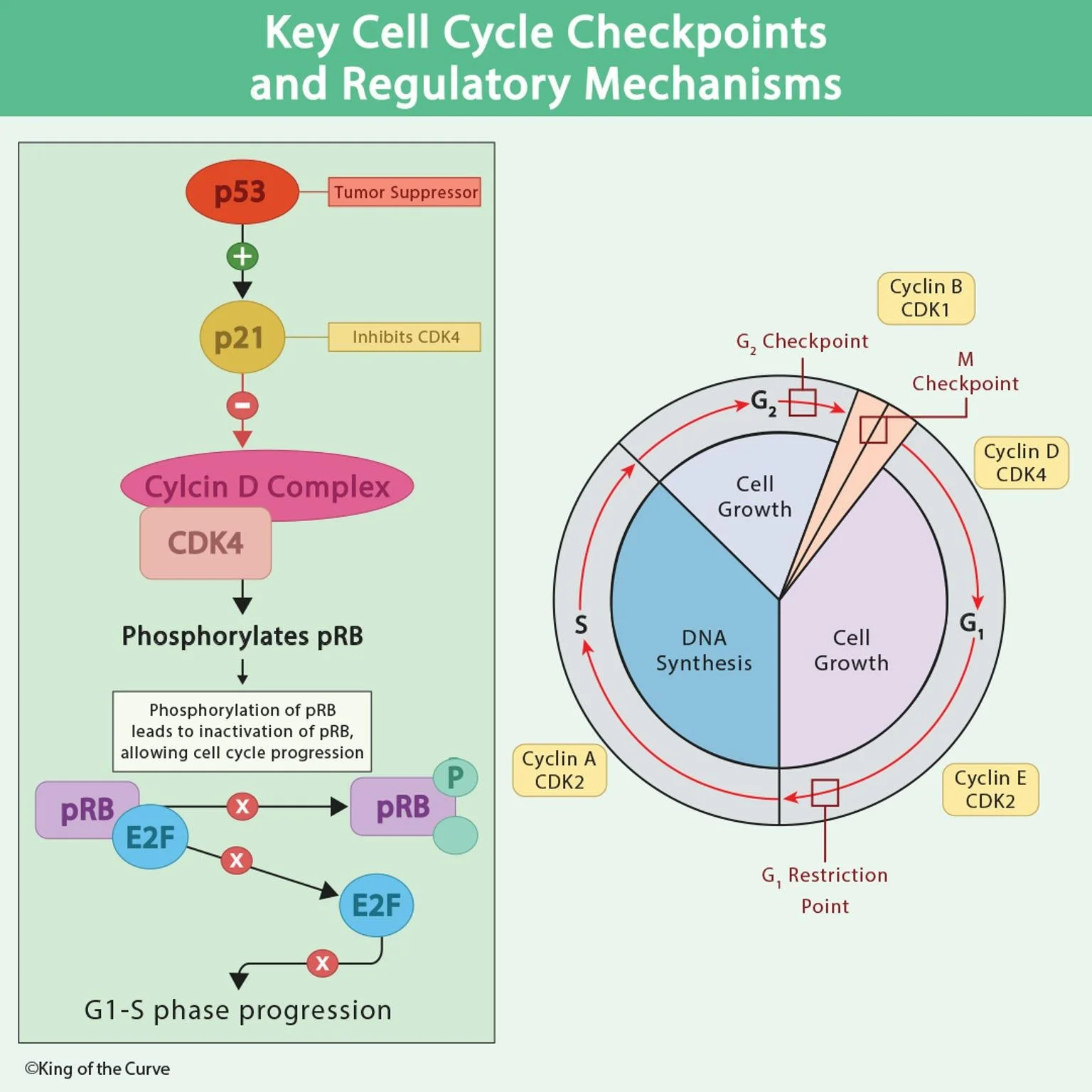🔬 Key Cell Cycle Checkpoints and Regulatory Mechanisms
The cell cycle is a tightly controlled process that governs how cells grow, replicate their DNA, and divide. To maintain genomic integrity and prevent uncontrolled proliferation, the cell cycle relies on checkpoints—control mechanisms that ensure each phase is completed accurately before progression to the next stage.
🧩 Overview of the Cell Cycle
The cell cycle consists of four main phases:
G₁ phase (Gap 1): Cell growth and preparation for DNA replication
S phase: DNA synthesis (replication)
G₂ phase (Gap 2): Further growth and preparation for mitosis
M phase: Mitosis, where one cell divides into two identical daughter cells
Between these phases lie crucial checkpoints that monitor DNA integrity, nutrient availability, and proper completion of earlier events.
⚙️ Key Checkpoints and Cyclin-CDK Complexes
The cell cycle is regulated by Cyclins and Cyclin-dependent kinases (CDKs) — proteins that activate or inhibit progression through checkpoints.
| Checkpoint | Cyclin–CDK Complex | Function |
|---|---|---|
| G₁ Restriction Point | Cyclin D / CDK4 | Ensures conditions are favorable for DNA replication. |
| G₁/S Transition | Cyclin E / CDK2 | Commits the cell to DNA synthesis. |
| S Phase | Cyclin A / CDK2 | Controls DNA replication. |
| G₂/M Checkpoint | Cyclin B / CDK1 | Ensures DNA replication is complete before mitosis. |
These complexes act as molecular “gatekeepers,” ensuring orderly progression through the cell cycle.
🧠 Molecular Regulation: The p53–p21–CDK4 Pathway
As illustrated, the p53 tumor suppressor protein is a master regulator of the cell cycle.
When DNA damage is detected, p53 activates p21, a CDK inhibitor.
p21 binds to and inhibits the Cyclin D–CDK4 complex, preventing phosphorylation of the retinoblastoma protein (pRB).
When pRB is phosphorylated, it releases E2F, a transcription factor that drives DNA synthesis genes.
By inhibiting CDK4, p21 keeps pRB active, blocking E2F and halting cell cycle progression from G₁ to S phase — giving the cell time to repair DNA damage.
This failsafe mechanism prevents propagation of genetic errors, reinforcing p53’s title as the “guardian of the genome.”
🧬 G₂ and M Phase Checkpoints
Following DNA replication, the G₂ checkpoint ensures that all chromosomes are fully and accurately copied before mitosis begins.
Cyclin A/CDK2 and Cyclin B/CDK1 complexes drive this transition.
If errors are detected, the cell cycle pauses to allow for DNA repair mechanisms to act.
During the M checkpoint, spindle fibers are monitored to confirm that chromosomes are properly aligned before division. This prevents aneuploidy — an abnormal number of chromosomes in daughter cells.
💡 Clinical Relevance
Many cancers arise from mutations in p53, pRB, or CDK pathway genes, leading to unchecked cell proliferation.
Modern cancer therapies, such as CDK inhibitors (e.g., Palbociclib), target these dysregulated checkpoints to restore control over cell division.
❤️ Summary Table
| Phase | Key Regulator | Checkpoint Function |
|---|---|---|
| G₁ Phase | Cyclin D–CDK4 | Monitors DNA damage before replication and controls entry into S phase. |
| S Phase | Cyclin A–CDK2 | Controls DNA synthesis and repair fidelity during replication. |
| G₂ Phase | Cyclin B–CDK1 | Verifies complete and accurate DNA replication before mitosis. |
| M Phase | Spindle Assembly Proteins | Ensures chromosomes are properly aligned before cell division. |
📚 Final Thoughts
The cell cycle is a marvel of biological precision. Every checkpoint represents a moment of decision — whether to proceed, pause, or repair.
Understanding these checkpoints not only provides insight into normal cell biology but also illuminates how cancer develops when these systems fail.
If you’re studying for the MCAT, USMLE, or other medical exams, mastering the p53-p21-CDK pathway and checkpoint mechanisms is essential for understanding oncology and molecular cell biology.
🚀 Call to Action
Want to visualize more high-yield biology concepts like this?
Visit King of the Curve for interactive diagrams, quizzes, and study tools that make mastering complex science simple, engaging, and unforgettable.
Frequently Asked Questions (FAQs)
-
Aim for 4-6 focused hours, ensuring you incorporate breaks to avoid burnout.
-
Practice mindfulness techniques, take practice exams under realistic conditions, and maintain a balanced lifestyle.
-
Set short-term goals, seek support from mentors, and reward yourself for small achievements.
-
Regular exercise improves focus, reduces stress, and enhances overall mental clarity.
-
KOTC offers personalized learning tools, gamification features, and adaptive question banks to help students stay on track without burnout.


